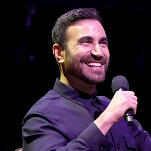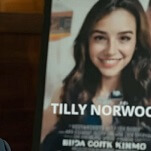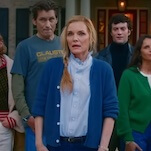Though John Ford is closely identified as a director of Westerns, he took a long break from the genre early in his career, letting 13 years go by between 1926’s silent 3 Bad Men and 1939’s Stagecoach. In the interim, Ford made comedies, political thrillers, war pictures, and melodramas, and adjusted to the sound era by perfecting his compositions and blocking, finding ways to reveal what the dialogue wasn’t saying. By the time Ford took on Stagecoach, he was more inclined to treat Westerns with the seriousness and artistry that he brought to every other project, and the result was a movie that introduced literary ambition to a previously low-rent genre. Stagecoach gives fine shading to a simple story, making it look and feel like a forgotten American myth.
The original 1938 Ernest Haycox short story “Stage To Lordsburg” sets the scene well: “This was one of those years in the Territory when Apache smoke signals spiraled up from the stony mountain summits and many a ranch cabin lay as a square of blackened ashes on the ground and the departure of a stage from Tonto was the beginning of an adventure that had no certain happy ending.” In Stagecoach, the coach sets out with an eclectic group of frontier Americans: Gambler John Carradine, sneaky banker Berton Churchill, pregnant cavalry wife Louise Platt, drunk doctor Thomas Mitchell, booze-slinger Donald Meek, stalwart marshal George Bancroft, and disgraced prostitute Claire Trevor. They’re joined by morally ambiguous cowboy John Wayne—introduced in one of the most awe-inspiring close-ups in movie history—who’s on his way to kill the man who murdered his father and brother. As the passengers make their way from one remote community to the next, stopping in cavalry outposts to rest, they contemplate the threat posed by Geronimo’s Apache warriors and the fates awaiting them when they reach their final destination.
Stagecoach has its moments of striking naturalism—a newborn baby here, a casual gesture there—and the story itself has a matter-of-factness that sets it apart from the majority of its Western predecessors. Ford and screenwriters Dudley Nichols and Ben Hecht invested the plots and characters from dime novels and two-reelers with human-scaled emotions. A large chunk of the movie is dedicated to the give-and-take between Wayne and Trevor, and whether his thirst for vengeance is worth squandering a chance to settle down with a woman who could make him happy. A decade later, directors like Anthony Mann, Budd Boetticher, and Howard Hawks would extend the realism of Stagecoach in Westerns that directly tackled their heroes and villains’ psyches and motivations. What makes Stagecoach special is that it also keeps one boot in the past, with thrilling stunts, chase scenes, and a visual style that resembles a vintage daguerreotype. Yet even while Wayne (or, more accurately, legendary stuntman Yakima Canutt) leaps from horse to horse, the movie takes a moment to look inside the coach, where Platt prays for safety from the attacking Apache, and Carradine prepares to answer her prayer by putting a bullet in her head. And though Ford makes Trevor iconic in one scene by showing her silhouetted in a doorway, he brings her back down to earth in another when he shows her hiding her cleavage from the leering doctor. Stagecoach was grander than the Westerns that came before, but also more modest. It was a genre all its own.
Key features: Criterion’s Blu-ray package (also available on DVD) befits a masterpiece, adding the long-lost 1917 Ford Western Bucking Broadway, plus an hourlong 1968 interview with Ford, assorted interviews with Ford experts, and a terrific commentary by scholar Jim Kitses, who sounds like a well-informed reincarnation of W.C. Fields.








































